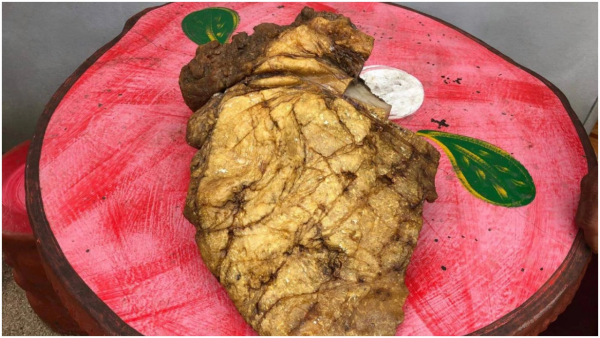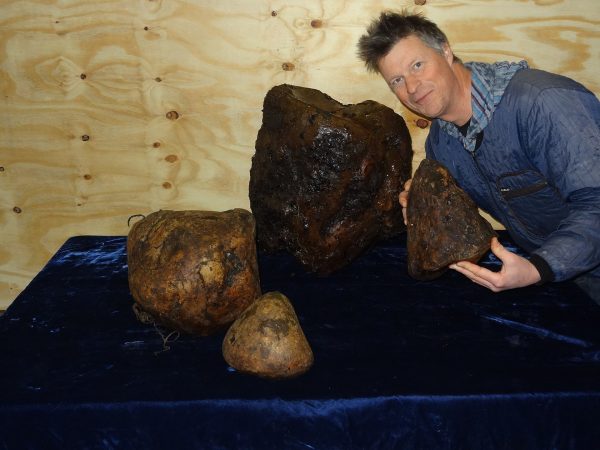Poor Fisherman Finds Lump of WHALE VOMIT Worth Third of a Million Dollars
In 2018, a fifty five year old fisherman, Jumrus Thiachot, from Koh Samui in southern Thailand was walking on the beach and found a fourteen pound mass of whale vomit.
Initially, he didn’t know what the mass was, but he was suspicious that it may be ambergris, commonly thought of as whale vomit.
The first test was unsuccessful, but after about a year, Thiachot contacted government officials who retested the mass and confirmed it was, in fact, 80% ambergris worth over three hundred and twenty thousand dollars.
Ambergris is a mixture of squid beaks, cuttlefish, ambrein, and epoprostenol and is created in the intestines of the sperm whale.
When a sharp or large object passes through, extra bile is secreted to aid the passage through the intestines. It is usually passed through and out the anus, but at times it is regurgitated and floats in the ocean as a waxy substance.

The smell is bad when it is fresh, as anything passing through the intestines of any mammal would be, but after a while it only has a slight musky smell.
Most ambergris washes ashore in China, Japan, the Americas, the Pacific islands, and Africa. In the novel, Moby Dick, Herman Melville refers to the smell as “a faint stream of perfume” according to Natural History Museum.
Encyclopaedia Britannica notes that proof exists that humans have been aware of ambergris since at least the fifteenth century. Marco Polo wrote about it thinking it was something the whales swallowed with their food.
A poor #Thai fisherman is set for a windfall after finding a valuable lump of whale vomit. Jumrus Thiachot spotted the mammal puke, which weighs around one stone, on the beach earlier this year. https://t.co/e4WcjDMYxL pic.twitter.com/jNzm5svLJx
— Bangkok Jack News (@BangkokJackNews) October 24, 2019
A letter published by the Royal Society of London claimed it was from unknown creatures that swarmed the oceans. Fossils have been found dating back almost two million years, and it is estimated by experts that humans have used ambergris for over one thousand years.
But why is whale vomit so valuable? The perfume industry began using the ambrein in the mass as a fixative for fragrances to make the scent last longer.
Early Arab communities used it as a spice and for medicine, incense, and as an aphrodisiac. The longer the substance floats on the water the more valuable it becomes.
In 2013, Ken Wilman of Morecambe, Lancashire in England was walking his dog, Madge, when she became very interested in a smelly six pound lump of what seemed to be a rock.

Not knowing what it was, Wilman shooed her away and they returned home. After a little bit of research Wilman realized what it was and hurried back to retrieve it.
Chris Hill, curator at the Aquarium of the Lakes in Newby Bridge, Cumbria, said, “How much it’s worth will depend on how fresh it is, but it’s potentially one hundred and eighty thousand dollars.”
According to CNN, a schoolboy from the United Kingdom found a mass almost one and one half pounds that ended up being worth sixty-three thousand dollars. ScienceAlert tells us that in 2016, three fishermen from Oman off the coast of Qurayat found a chunk weighing one hundred seventy six pounds worth about three million dollars.
The same year, an almost three and one half pound piece was found by Gary Williams of the United Kingdom estimated to bring about seventy thousand dollars. According to Whale and Dolphin Conservation, the largest hunk was found near Australia in 1913 weighing just over one thousand pounds.
In the United Kingdom and most European countries, selling ambergris is legal as it is treated as a byproduct by the Convention on International Trade in Endangered Species, but in the United States, sperm whales are protected under the Endangered Species Act of 1973 which includes any product or byproduct of the whale.
Australia’s import and export laws established under Part 13A of the Environment Protection and Biodiversity Conservation Act, 1999 also strictly regulates the use of whale products.
Another Article From Us: Roman Chariot & Horses Found in Burial Chamber
Fortunately, science has been able to replicate the ambrein found in ambergris and only the most expensive perfumes contain real ambrein.





